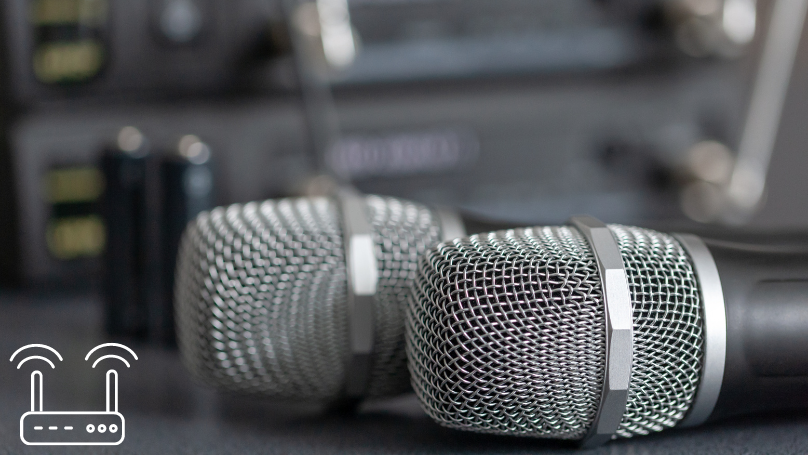The best wireless microphones and wireless systems can be take a home or professional recording studio to the next level.
Cordless mics are an essential piece of voice-over equipment and are regularly used by voice actors, singers, speakers, journalists, and others.
Wireless microphones allow the performer to move around freely without having to worry about tripping over cables. This can be particularly useful for singers or dancers who need to move around a lot. It can also be useful in a studio setting for voice over artists who like the freedom to move around a bit when recording.
Of course there are tons of different wireless microphone systems available on the market, so it’s important to do your research before purchasing one.
The best wireless microphones will offer good sound quality, reliability, and range.
They will also be easy to use, and ideally will come with a carrying case for easy transport.
If you’re looking for a wireless microphone system for your studio or live performances, be sure to check out our 2023 picks in the guide below.
We’ve reviewed and rated dozens of different models over the past few years, and below, you’ll see our picks for the best wireless mics based on their quality, durability, features, customer reviews, cost, and other key factors.
Don’t feel like reading the full guide? Here are a couple of my good wireless microphones that are my favorites:
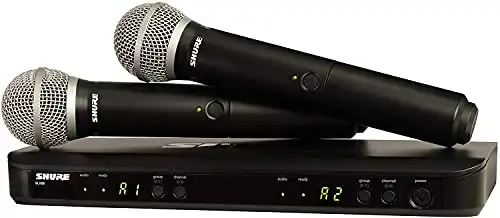 Shure BLX288/PG58 Wireless Microphone System
Shure BLX288/PG58 Wireless Microphone System
What’s inside?
- Dual-channel wireless system with two handheld vocal mics
- 50 Hz to 16 kHz frequency range
- Includes the Shure BLX88 dual-band wireless receiver
- Battery-operated cordless microphones have a cardioid pickup pattern
- Adjustable gain control
Killer features: Wide bandwidth of 524 to 865 MHz
You can count on Shure for durability and quality. This system is exceptional. The sound of this wireless system is crisp and clear with no dropouts. The cardioid pickup pattern prevents the device from having feedback problems. The adjustable frequency bandwidth for the wireless signal allows you to select the best frequency to avoid any interference with the signal.
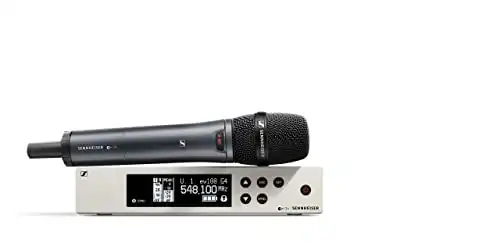 Sennheiser Pro Audio Sennheiser EW 100-835S Wireless Dynamic Cardioid Microphone System-A Band (516-558Mhz), 100 G4-835-S-A
Sennheiser Pro Audio Sennheiser EW 100-835S Wireless Dynamic Cardioid Microphone System-A Band (516-558Mhz), 100 G4-835-S-A
What’s inside?
- This is a single-mic system
- The cordless microphone and receiver synchronize using an infrared signal
- The product has an aluminum body and the transmitter casing is also aluminum
- The model has an on/off switch
- The transmission range is up to 300 feet (line of sight)
Killer features: Up to 20 compatible wireless channels
This is my choice if you want to use just a single device. Sennheiser sells this as a bundle with your choice of microphone that can be a cardioid or super-cardioid dynamic, condenser, or lavalier mic. You can start with one type and then add other options thereafter for different uses. This system is compact and easy to use.
4 Steps to Find The Right Wireless Microphone System (WMS)
Not all wireless microphones are the same. Some offer better sound quality than others, while some have a greater range.
It’s important to do your research before purchasing a wireless microphone system, as not all of them are created equal.
When I think about WMS that I would like to add to my audio recording and sound reinforcement tools, I always take the following four steps in my evaluations.

Step 1: Determine Your Budget
Before purchasing a wireless microphone system, it’s important to set a budget. This will help you to narrow down your options and find the best system for your needs.
As you’ll see in our guide below, there are wireless microphones that range in price from under a hundred bucks up to nearly a thousand dollars or even more in some cases.
There are a variety of different wireless microphone systems available on the market, so it’s important to find one that fits your budget.
When considering a wireless system, you may want to buy the receiver and one type of microphone to get started, with the plan to add more equipment later that is compatible.
Step 2: Consider Your Recording or Event Environment
It is critical to evaluate the places and the type of events where you plan to use a WMS. Interference problems may cause a signal interruption. Physical barriers, such as walls or set pieces, may reduce the signal transmission range. Having a clear line of sight between a transmitter and a receiver is vital for a decent signal path.
I prefer to buy higher-quality WMS equipment because I want my gear to be durable when I use it for public events. Many bad things happen to the equipment in a live-performance environment.

Performers drop the microphones, spill things on the gear, and basically find many clever ways to abuse the wireless systems. I even had a performer drop a lavalier mic in the toilet. I fished it out with the help of a pair of metal tongs, rinsed it off, and then let it dry before trying to test it. I was amazed when it still worked. If this happens to you, the trick is to make sure it is completely dry before using it again.
Think about how performers may move around, such as if they might go down from the stage to the audience level. Test the wireless system before any performance to ensure there are no drop-outs caused by how a performer might move around during a show.
In any event space, which has simultaneous live events, such as a conference setting, be sure to know what other events are happening nearby. If another wireless system operates on the same frequency, interference between the live shows/presentations is possible.
Step 3: Choose the Type of Mic and System
There are many cordless microphones and systems to choose from, such as handheld mics with a transmitter, a headset mic, or a lavalier one with a bodypack transmitter. There is the choice of an analog vs. a digital WMS. A digital system transmits at an extremely high-frequency range reserved for certain electronic equipment.
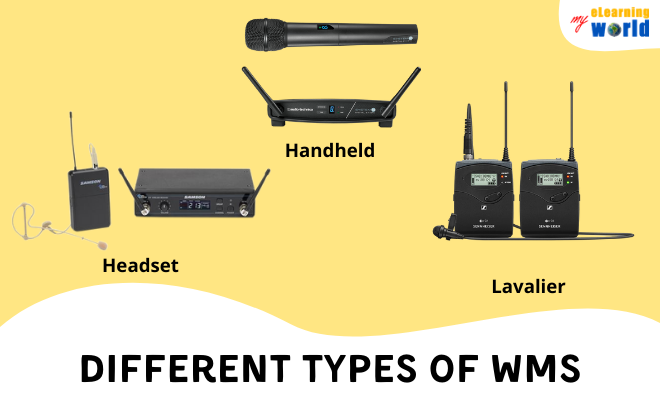
You also want to decide if you prefer the system to use a USB connector or an XLR connector. A system with a USB connector can plug in directly to a computer. A system using an XLR connector usually needs to be plugged into another device, such as an audio interface, an amplifier, or a mixing board. If the microphone is a condenser style and requires phantom power to operate, the XLR connector provides this phantom power.
Step 4: Evaluate the Specifications
Here is my checklist of the specifications and considerations that I think about before buying a WMS.
- Price/Value: There is always a trade-off between the price of equipment and the value for the price. Since I use my gear constantly, I like better-quality gear even if the price is higher.
- Durability: The construction build that uses all-metal pieces is superior to any devices that are made from plastic. When testing a new model, the first thing I do is to drop it on a concrete floor from a height of six feet. If it cannot withstand this type of abuse, it is not useful to me for live performances.
- Noise Floor: The noise floor of a cordless microphone is the sound that the equipment makes when recording silence. You want the noise floor to be as quiet as possible.
Wireless mics tend to pick up noise from the electrical system. If you are using it and suddenly hear a buzzing sound, check to see if anything is plugged-in to the same electrical circuit that the receiver is using. A noise may come through the electrical system from things like a power drill or a vacuum cleaner.
Depending on the wireless transmission frequency, a cordless mic can pick up noise from television or radio broadcasts. - Transmission Range: The transmission range may be of concern for certain applications, such as running the sound mixing board from the back of a large room with the stage on the opposite end.
- Transmission Frequencies: Higher frequencies are able to penetrate barriers more easily and have longer transmission ranges. The adjustability of the transmission channels is highly-preferred so that you do not have any problems with signal interference that could ruin your show/presentation.
- Simultaneous Mic Use Capability: There are systems for a single cordless microphone, dual-mic systems, and systems that can accommodate four or eight devices. If you have a smaller system, you may run into a problem when adding a second system if it uses the same transmission frequencies as the first one.
- Battery Life and Rechargeable Batteries: Battery life needs to be long enough to cover the event length, including the set-up time. Rechargeable batteries are preferred to save money otherwise spent replacing them constantly with new ones.
- Warranty:
I like to have at least a one-year warranty on any major equipment purchases. I prefer to buy from a manufacturer that offers U.S.-based customer service. Even if the factory is located elsewhere, they need to maintain a physical presence in America that provides warranty repairs. Otherwise, you will find that shipping your equipment to the factory, for example, in China, is too costly to justify the expense.
If you must buy a cordless mic with a very low-budget price, I suggest you buy two of them. Keep one in reserve to use if the other one suddenly breaks in the middle of a show or presentation.
Those are the considerations for WMS that will help you decide which cordless microphones are best for your needs.
Choosing the Best Wireless Microphone and Wireless System
I separated my reviews into four categories of wireless systems:
1) Single WMS;
2) Dual WMS;
3) 4 WMS;
4) 8 WMS.
If you are new to WMS or need a quick refresher, here is an overview of how cordless microphones and systems work in this video from ProSound and Stage Lighting.
Here is the list of the 14 Best Cordless Microphones that I reviewed. Following this list, I took a deep dive into the specifications of each product and its features.
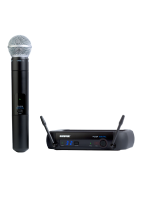 |
Great live sound for your voice-overs or church performances. Category: Single WMS
| Amazon → |
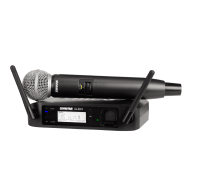 |
Designed for the professional singer or speaker who performs live. Category: Single WMS
| Amazon → |
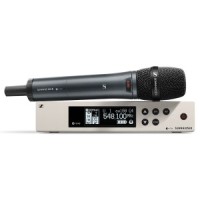 |
The best pick for sound designers or occasional users. Category: Single WMS
My choice among single wireless microphone systems
| Amazon → |
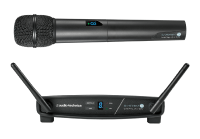 |
Good choice for vocalists and live speakers to use in a large room. Category: Single WMS
| B&H → |
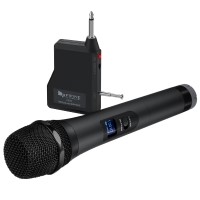 |
For the budget-conscious. Good for use with karaoke. Category: Single WMS
| Amazon → |
 |
Suitable for use where the device can be dropped like at a karaoke party because it is very low-priced at around $30. Category: Single WMS
| Amazon → |
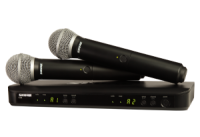 |
For a vocalist who likes to move around the stage freely. Also has a wireless instrument connector Category: Dual WMS
My choice among wireless microphone systems
| Reverb → |
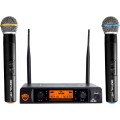 |
Perfect for stage performance at a modest price. Category: Dual WMS
| Amazon → |
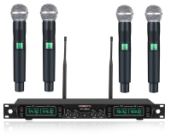 |
Turn on the receiver, and start your outdoor activity. Category: 4 WMS
| Amazon → |
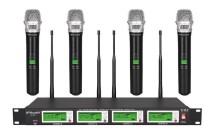 |
Superb choice for professional live concert settings and live presentations Category: 4 WMS
| Amazon → |
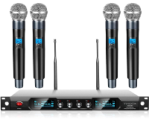 |
Good for karaoke, churches, live performances. Category: 4 WMS
| Amazon → |
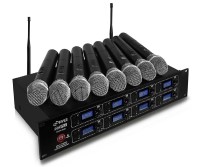 |
Decent system with good value for a place where no interference problems are expected. Category: 8 WMS
| Amazon → |
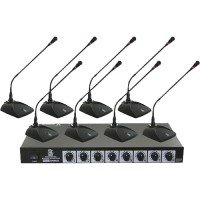 |
Suitable for a conference panel or meeting with multiple speakers. Category: 8 WMS
| Amazon → |
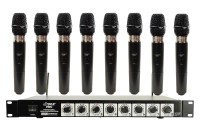 |
Good system for those traveling to countries with a different electrical power supply standard Category: 8 WMS
| Amazon → |
And now, let’s get to my in-depth reviews of the detailed specifications of each product, broken down by category.
Single Wireless Microphone Systems
If you perform as solo person, here are some of the best single wireless microphone systems:
1. Shure PGXD24/SM58-X8
Shure PGXD24/SM58-X8 has two channels but comes with one wireless microphone. This system is compatible with the SM58 and other cordless models made by Shure.

Features
This receiver for this system has two antennas and two independent receivers for digital diversity and to make sure there is no signal drop. The receiver is constantly working to lock in on a solid radio frequency (RF) signal. Using a one-touch scan button on the receiver finds a clear frequency. The model has a cardioid pickup pattern to deliver clear vocals and speech. Guitar Center gives a positive review of this system.
Killer feature: Uses double antennas and dual channels for a stable RF connection.
Pros
- Up to nine hours of continuous use from fresh AA batteries.
- Automatic syncing between the receiver and the mic.
- Up to 200 feet of operating range.
- Settings on the model are lockable to prevent accidental changes.
Cons
- To sync the microphone with the receiver, you have to take off the bottom cover to find the button.
- To change the mic’s gain, you have to take off the top cover.
- The model can cause feedback problems.

Best for: For those who like the look, feel, and performance of a wired Shure SM58, this is the same model in a wireless version.
This video, produced by Tek Overclocked, shows how to use the device processed through his Reaper sound processing, and then he turns off the signal processing to show what it sounds like clean.
The reviewer answers the question of whether it is worth paying around $380 for this product. He thinks it is. He recommends using it with a pop filter on it. He uses this model at his church. He demonstrates the cardioid microphone pickup pattern by showing how it sounds when talking at the side. He shows how he uses EQ to bring down the low-end slightly and enhance the high-end, with a little reverb added, to get a great live sound for his voice-overs.
Buying Options
- Check price on Amazon →
- Check price on B&H →
- Check price on Sweetwater →
- Check price on Guitar Center →
2. Shure GLXD24/SM58-Z2
Shure GLXD24/SM58 costs around $500, making it one of Shure’s top-of-the-line models. This is a system preferred by professional singers.

Features
The system includes a GLXD4 receiver and one GLXD2 transmitter with an SM58 cardioid mic. It uses intelligent frequency management to lock on the best open frequencies quickly. It is possible to use four (and maybe up to eight) compatible systems in proximity to each other under ideal conditions. The model operates up to 18 hours on one battery charge.
Killer feature: This product works with a rechargeable lithium-ion battery.
Pros
- There is no need to waste money buying disposable batteries because the lithium-ion battery included is rechargeable.
- Uses LINKFREQ automatic frequency management.
- Has a clear digital sound.
- Uses the globally-license-free 2.4 GHz frequency band.
- Comes with a USB charging cable and a carrying case with fitted foam for the entire system.
Cons
-
- May not perform as well in challenging environments
- Very pricey, but considered worth the investment.
- Power cord is not good quality.
- Heavy Wi-Fi usage near this system may cause interference.

Best for: This device is designed for the professional singer or speaker who always wants to sound consistent when performing live.
This video, produced by Shure, discusses the challenges encountered when using this system, which includes using it outdoors or in places with high ceilings.
The video shows how to configure the system in difficult places. It gives tips about the line of sight, usage near the receiver, and how to deal with Wi-Fi signals. It shows how to use the group-two frequency setting to find clearer frequencies with the most robust performance characteristics.
Buying Options
- Check price on Amazon →
- Check price on B&H →
- Check price on Sweetwater →
- Check price on Guitar Center →
3. Sennheiser EW 100 G4-835-S
The Sennheiser EW 100 wireless receiver system can be matched with a Sennheiser 835S dynamic cardioid mic or many other Sennheiser cordless models. This is my top pick in this category that works with one device at a time.

Features
This is my favorite one-mic system because Sennheiser makes so many styles of cordless microphones that are compatible with this system according to the Sennheiser specifications. It comes bundled with an 835S dynamic mic with a cardioid pickup pattern. There are compatible Sennheiser omnidirectional lavalier and headset models. The lavalier mic style is also available with a cardioid pickup pattern. There is a condenser microphone offered as well. An optional instrument cable input can be used to connect instruments to the receiver.
Killer feature: This system offers up to 20 compatible wireless channels.
Pros
- This one-channel system is easy to use and very flexible.
- The mic body and receiver chassis are made of aluminum.
- The transmission range is up to 300 feet (line of sight)
- The microphone and receiver easily sync using an infrared signal.
- The model has a nice digital display showing the frequency, strength, and battery level.
Cons
- A bit pricey for a single-channel system.
- Channels are in a somewhat narrow bandwidth range of 516 to 558 MHz.
- If you grab the bottom of the product, you can inadvertently block the mic’s antenna and cause the device signal to cut out.

Best for: If you need a system that uses one device at a time but has the option to use many different mic styles that are compatible, this system is an exceptional choice for its flexibility.
This video, produced by Church Audio Life, shows the kit’s unboxing that contains an E835 model with an EM 100 receiver. It comes with a rack mount kit included and a power adaptor.
The reviewer talks about how he used this system for about a year and the SQM 100 mic, allowing it to be interchanged with another head for a different pickup pattern. The product is easy to take apart and clean. It uses two AA batteries, which last longer than 9-volt batteries. Optional rings are available to color code the microphone. It has a sensitivity adjustment. The reviewer compares this fourth-generation system to the previous third-generation version.
Buying Options
- Check price on Amazon →
- Check price on Sennheiser →
- Check price on B&H →
- Check price on Sweetwater →
4. Audio-Technica System 10 ATW-1102
Audio-Technica System 10 ATW-1102 is a digital 24-bit/48 kHz wireless system that provides excellent sound and reliable performance. Operating this system is easy, with instant channel selection and syncing between the mic and the receiver for a fast set-up.
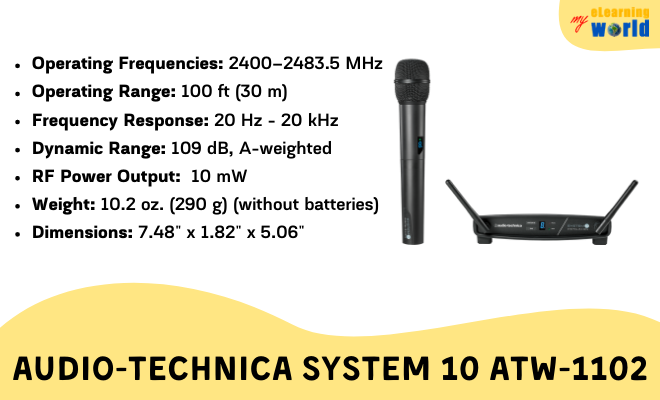
Features
This system operates in the 2.4 GHz range, which keeps it completely free from any interference caused by broadcast television signals. The system comes with an ATW-R1100 receiver and an ATW-T1002 handheld dynamic microphone/transmitter. The mic is unidirectional. An AT8456a Quiet-Flex™ stand clamp is included. Here is the Guitar Center review.
Killer feature: Automatic frequency selection with eight channels.
Pros
- Up to eight channels can be used simultaneously without experiencing any interference.
- The system receiver and transmitter on the product both have an easy-to-read display.
- Space diversity uses two antennas on each transmitter and receiver to create the maximum signal integrity.
- Comes with a handheld model and works with other mic styles.
- The ATW-R1100 receiver has volume control and AF Peak and Pairing indicator lights.
Cons
- Receiver only accepts one transmitter at a time.
- The product’s on/off switch can be used by a performer inadvertently to turn off the device.
- A blinking light warns only when the battery is running very low and about to go off.

Best for: This is a good performance model for vocalists and also excellent for live speakers to use in a large room.
This video, produced by Audio-Technica, shows the unboxing of the System 10. The System 10 is the first foray into the digital wireless mic category made by Audio Technica.
The interviewer says the System 10 is available in a handheld version. It also comes as a bodypack system for an instrument cable, head-worn, or a lavalier mic. The warranty is two years. This system is a full-duplex system. This means the wireless system is always communicating between the receiver and the microphone. It has three levels of diversity assurance to ensure the RF signal is solid, to avoid drop-outs.
Buying Options
5. FIFINE K025
The Fifine wireless system is super cheap at around $30. It is useful for those who want the freedom to move around with a microphone at events and live performances.
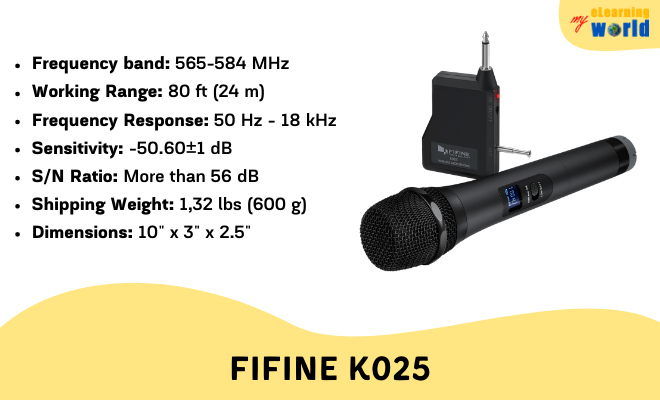
Features
This system is easy to use. It is plug-and-play with 20 selectable UHF frequencies. The model is lightweight. It comes with a receiver with a 1/4-inch output jack to connect to a DJ mixer or an amplifier.
You can read the Fifine specs and the FAQ to get more details about this system.
Killer feature: It is super cheap.
Pros
- The device has a cardioid pickup pattern to avoid causing feedback.
- It is comfortable and easy to hold.
- The product has a low-battery warning light.
- Low price.
- One-year warranty.
Cons
- Batteries are not included.
- Not very durable. Made of ABS plastic.
- Subject to interference from broadcast television UHF signals.
- Range is just over 80 feet compared to up to 300 feet for more expensive systems.
- Needs an amp (not included) to work with the receiver.
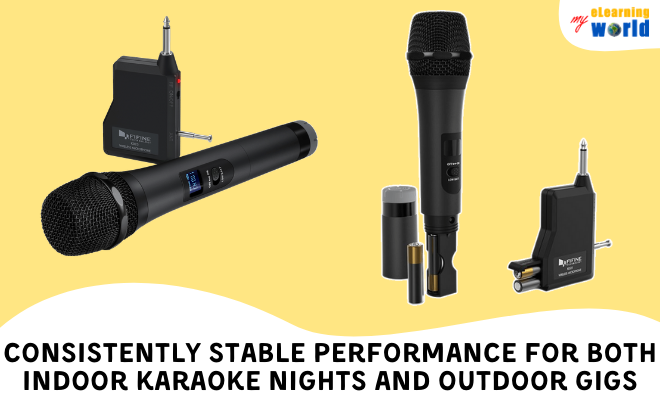
Best for: Those on a budget who need a WMS and only have a small amount to spend.
This video, produced by Tobias Holenstein, shows him opening the box and testing the device. He takes it outside to test the range. He has a cute dog watching him and gets help with the test from his parents sitting outside.
The reviewer says he thinks this product would be good for use with karaoke because it is so cheap, and if dropped, it would not be a great loss. He tests the range to see if it is 65 feet, which it is. The mic takes two AA batteries, and the receiver takes two AAA batteries. He demonstrates the audio quality and thinks it is pretty good.
Buying Options
6. TONOR TW-620
The TONOR TW-620 system is inexpensive and can be used with up to 14 other matching mic transmitter/receiver systems set to a different channel. There are 15 channels to choose from to avoid interference and use more than one system simultaneously.

Features
One set of microphone transmitter and receiver costs about $30. This budget price makes them perfect for casual uses such as karaoke. The receiver plugs into a mixing board or an amplifier using a 1/4-inch (6.35 mm) stereo plug. It has an operating range of up to 200 feet (line of sight) and other nice specifications. You may want to consult the FAQ to learn more.
Killer feature: Comes with a rechargeable battery system for the receiver that lasts up to eight hours on a full charge.
Pros
- Rugged metal construction.
- It has a cardioid pickup pattern to avoid feedback.
- The receiver portion of the system is rechargeable in about two or three hours.
- Receiver and mic automatically sync when turned on.
- Comes with a microphone cover and a USB charging cable.
Cons
- The model is NOT rechargeable and uses two AA batteries (not included).
- The pickup pattern is very tight, which means you must sing or speak right into the mic.
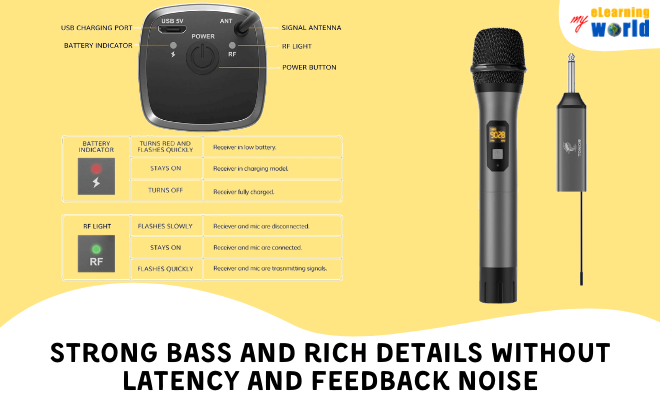
Best for: This system is good for use where the device can be dropped like at a karaoke party because it is not expensive if you need to replace it.
This video, produced by xBert, shows the reviewer opening the box, which says on it “Made in China.” To me, this means if you have any problems, you will have to throw it away. Chinese manufacturers are notoriously bad at customer service.
The reviewer talks about the same system, but he reviews the TW-630 version that comes with two mics instead of just one and includes the batteries. The reviewer goes outside, and there is plenty of static when the walls block the signal.
Buying Options
If you are looking for other budget options that connect by cables, check out the reviews of the Best Budget Microphones.
Dual Wireless Microphone Systems
If you perform with someone else or maybe you sing with a guitar, then you’ll want to look into a dual wireless mic system, like the ones below.
7. Shure BLX288/PG58
The system has two PC58 cordless mics and the BLX88 wireless receiver. This is my choice for the best wireless system in this category.

Features
Compare the two devices used with this system to the Shure SM58, which is the same wired mic that is a favorite with musicians. The PG58 model is the same shape and size and has a battery-operated cordless transmitter in the handle. This system is not the cheapest one in this category; however, it is probably the best-built one. For that reason, I feel it is worth the price. The Guitar Center review agrees with my assessment.
Killer feature: There is a bandwidth choice for the wireless signal of 524 MHz to 865 MHz.
Pros
- Has an on/off switch on the microphone body.
- LED battery indicator shows green when a battery is charged and red when not charged
- Has a one-touch quick scanning feature on the receiver to find the best open frequency.
- There is automatic mic/receiver frequency matching.
Cons
- The chassis and frame are made from durable ABS polymer instead of metal.
- Receiver is not rack mountable.
- Microphones held too close to each other may cause interference.
- The battery LED light does not warn soon enough if the battery starts to get low.

Best for: This system is very good for a vocalist to use who likes to move around the stage freely without having to be tethered to a wired mic.
This video, produced by Perform Wireless, covers all the features of these cordless mics and the receiver.
The reviewer notes that the receiver also has a wireless instrument connector if you want to connect with cordless instruments. The receiver uses XLR connectors to connect to a mixing board or an amp. The PS58 model uses two AA batteries. The system is straightforward to use. The reviewer demonstrates how far away he can go (line of sight) and still have the receiver pick up the wireless transmission from a device.
Buying Options
8. Nady DW-22
The Nady DW-22 system has excellent digital sound quality with QPSK modulation and operates over the UHF frequency range. It has a line-of-sight transmission range of up to 300 feet.

Features
This system has ultra-low latency. I’m not too fond of the inability to choose another frequency on a fixed frequency system. If you experience interference, you are stuck, so I cannot recommend this system except for completely isolated usage. Take a closer look at the Nady specifications and see the Musician’s Friend review and the Guitar Center review to get some other opinions.
Killer feature: Extended range of up to 300 feet.
Pros
- Comes with two microphones.
- 48 kHz/24-bit digital conversion for clear audio.
- Long range operation up to 300 feet (line of sight).
Cons
- This is a dual fixed-frequency system that may interfere with other wireless systems.
- Uses two regular AA batteries.
- Poorly made.
- May fail to work after a short time.

Best for: Gamblers who don’t mind losing money.
This video, produced by Kennis Russell, is positive. He talks about what he did but does not show a demonstration. He tested the transmission up to 300 feet, and it worked.
The sound quality is decent. The reviewer says he used the pair of mics to sing with his niece. He talks about the system having a fixed frequency. This makes it easy to use but is asking for interference trouble.
Buying Options
Quad Wireless Microphone Systems
Here are my picks for the best Quad wireless microphone systems. I’ve included some cheap options for group performances and one option for professional live concerts:
9. Phenyx Pro PTU-5000A
The Phenyx Pro PTU-5000A system comes with four mics. Each device is set at a different but fixed frequency in the UHF range.

Features
This system works long-range of up to 260 feet. The devices and the chassis for the receiver are made from metal. They sell in a set of four with a frequency group of either one or two options, so it is possible to use two systems set to different frequency groups and have eight mics that do not interfere with each other. Here is a link to the full Phenyx Prop specs.
Pros
- The display screen on the microphone turns from green to red color when the battery is low. Eight AA batteries are included.
- They have an on/off switch discretely placed at the bottom in a protected place to avoid hitting it by accident.
- The receiver has balanced XLR outputs (one for each channel) and a mixed 1/4-inch output of all channels.
- Rack mountable.
Cons
- Frequencies cannot be changed so that this system may suffer from interference problems.
- This is an older model selling at a discount. There is a newer model that costs $100 more.
- The LED screen is fake and printed to make it look like a digital read-out. All this screen actually does is change color to indicate battery failure.

Best for: This is a good system for those on a budget who do not expect to have any interference problems and only need four mics.
This video, produced by Garrett Plays, shows the unboxing and testing of the system with two handheld microphones, a lavalier mic, and a headset one.
The reviewer likes the lavalier mic for how it is built with a three-pin XLR connector. The handheld ones are all metal. The setup is easy. He puts in the batteries, turns on the receiver, and connects it to his computer for recording voice-over using the lavalier mic. He likes it the best when compared to the handheld one.
Buying Options
10. GTD Audio G-787H
The GTD Audio G-787H system is my favorite if you need four microphones or more. With 800 selectable channels and UHF diversity, up to 20 sets of four devices, each can be used together.

Features
I really love this system for professional use because of its flexibility. It is a good value and sells for around $300. In a professional setting, the two things that can ruin a live show are mic interference and dropouts. This system has true diversity for increased operating range and signal reliability. Check out the full GTD Audio specs.
Killer feature: This system has an extended operating range of up to 600 feet.
Pros
- There are 800 selectable UHF frequencies per channel.
- This system has automatic frequency scanning to lock on the best interference-free settings.
- The programmable frequency range for the transmission signal is UHF 550 MHz to 590 MHz.
- Transmitter setup is automatic.
- The mics and the receiver are easy to synchronize.
Cons
- Battery life is only moderate so be sure to have plenty of spare batteries.
- Does not recharge batteries.
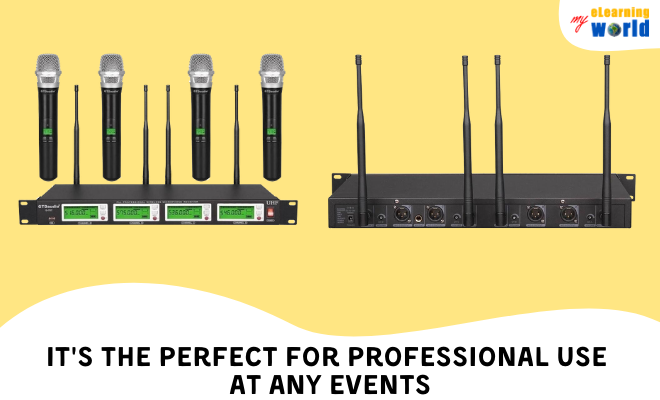
Best for: This system is a superb choice for professional live concert settings and live presentations.
Buying Options
11. Innopow WM-400
The Innopow WM-400 system has four fixed-frequency mics in the UHF range. The operational range is up to 240 feet.

Features
Each microphone channel in this system has an individual volume control. On the receiver’s back are four XLR individual outputs (one for each mic) and a 1.4-inch (6.35 mm) mixed output. The model has a unidirectional neodymium dynamic cartridge for a nice sound with minimal feedback problems.
Killer feature: The battery life for the devices is up to 17 hours of continuous use.
Pros
- Durable all-metal microphone body.
- This has a low price for a four-mic system, selling for less than $180.
- Has a 24-month limited warranty, but warranty repair requires shipping the product back to China.
Cons
- The microphone channels operate on fixed frequencies.
- There are only two antennas.
- They have an on/off switch but do not have a mute feature. Turning a device off while the system is on makes a loud click.

Best for: This system is best to use in places where no interference is expected to occur.
This video, produced by Aplomb, discusses the specifications of the system. The reviewer shows the fixed frequency of each device printed on a box label. You need to make sure the frequencies do not conflict with any other equipment you plan to use.
The reviewer says this system is good for karaoke, churches, and live performances. He does an unboxing. He likes the build of its metal body. Batteries are included. It uses two AA batteries per mic. Each one has a digital display.
Buying Options
8-Wireless-Microphone Systems
Pyle gives a great range of wireless microphone systems that come with 8 mics to cover all your needs. Here are some of my top picks.
12. Pyle PDWM8250
Pyle PDWM8250 comes with eight mics. The receiver is a rack mount style. It operates using Base RF and AF radio/audio frequencies.
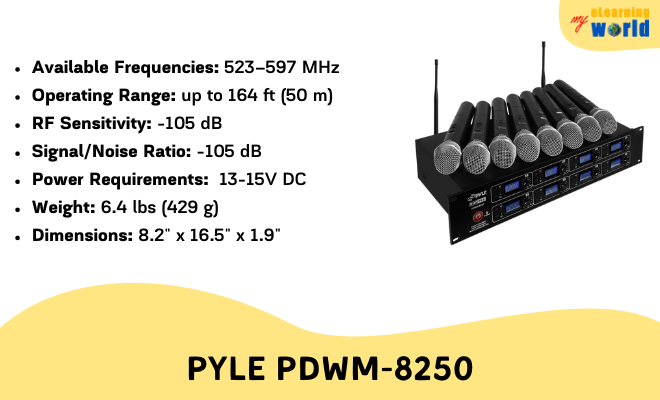
Features
Each channel in this system has an independent volume control knob on the receiver. The receiver has eight digital display windows to match the digital displays on each device. These displays show the operating channel number and the frequency being used by each channel. Take a look at the full Pyle Audio 8250 specs.
Killer feature: Easy to set up and use with eight microphones.
Pros
- Has eight independently controllable channels with XLR outputs.
- Has two 1/4-inch outputs. One is a mix of channels – one to four and the other is a mix of channels – four to eight.
- Operating range is up to 164 feet.
- Automatic setup.
- They have an on/off and a mute switch.
- Limited one-year manufacturer’s warranty.
Cons
- Pre-set UHF frequencies for each channel are not adjustable.
- Subject to interference problems.
- Horrible customer service.

Best for: This is a decent system with good value if you can use it in a place where no interference problems are expected.
This video is produced by The Awesome Guy 101. The reviewer only does the unboxing. He says this system was released in 2016.
You can see what comes in the box, but the reviewer does not test the system.
Buying Options
13. Pyle PDWM8300
Pyle PDWM8300 is an eight-channel system with eight desk-stand-type mics to use for conferences and panels of speakers.
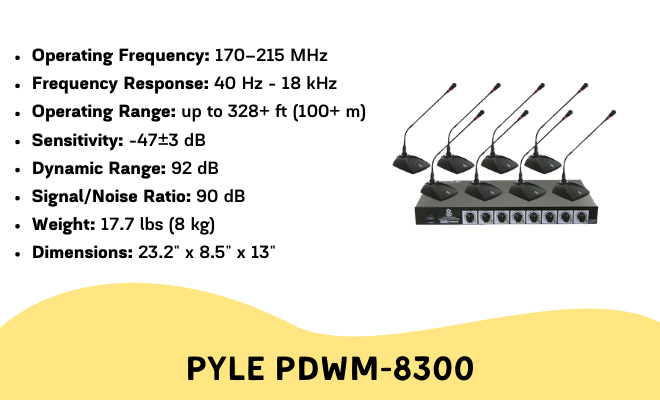
Features
This is a system for those who want a budget-priced solution with eight devices. It sells for around $270 for the kit. Take a look at the full Pyle Audio 8300 specs.
Killer feature: It is low-priced for an eight-mic system.
Pros
- There is an independent microphone volume control on the receiver for each channel.
- Super easy to set up.
- Rack mountable receiver.
- Frequency response of 50 Hz to 16 KHz with a high signal-to-noise ratio for better performance.
- Eight 9-volt batteries for the devices are included.
Cons
- Uses VHF frequencies (174 MHz to 216 MHz) that are subject to interference from television broadcast signals.
- Only one balanced XLR jack and one 1/4-inch mixed output.
- Uses 9-volt batteries that discharge rapidly.

Best for: This system is designed for conferences with panels of speakers.
Buying Options
14. Pyle PDWM8400
Pyle PDWM8400 system comes with eight handheld mics. Each channel has an independent volume control knob on the receiver. The receiver has a mixed 1/4-inch output.

Features
This is a budget system selling for around $223. It is simple to set up. Just put the batteries in the device, attach the antennas to the receiver, plug the receiver in, connect it to a mixer or amp, and turn everything on. Check out the Pyle Audio 8400 specs. and the Provantage review.
Killer feature: This system has a 110/240V power switch to be used in America and Europe.
Pros
- Low-price.
- They have a low-voltage indicator light to show when the battery is getting low.
- Rack mountable receiver.
- Uses either a 110V or 240V power source for the receiver.
Cons
- This system uses VHF frequencies that are subject to interference from television broadcast signals.
- Decent for speaking, but not really suitable for singing.
- The mics use 9-volt batteries that discharge quickly.

Best for: This is a good system for those traveling to countries with different electrical power supply standard.
This video, produced by pylecustomerreview, talks about his using this system for conferences at his church. The reviewer likes the choices of microphones that work with this system.
The reviewer shows had easy it is to set up. He turns the system on and demonstrates what it sounds like with a handheld mic.
Buying Options
Dynamic microphones that have an XLR cable are more durable than a cordless dynamic mic. A wireless one has a transmitter within the handle, which is more easily broken when dropped. If you plan to use dynamic microphones in live performances, be sure to have spared them if you go with wireless ones, in case a cordless mic stops working.
Other Wireless Mic Options
Some Wireless Systems are designed to work with lavalier microphones and headset ones. Find out more about their work in my wireless mic guide.
Lavalier Microphones

Here are a couple choices for lavalier mics to consider:
- The Movo PM10 Deluxe Lavalier can be used with an iPhone, iPad, Android, or another smartphone.
- The Sennheiser EW 112P G4 is a very expensive (around $600), high-quality, lavalier microphone and wireless system.
Headset Microphones

Some choices of headset microphones to consider are:
- The Shure BLX14/SM31-H9 is a WMS with a bodypack and a headset mic.
- The Fifine K037B is a low-cost (around $49) WMS with a headset and lapel mics, beltpack transmitter, and receiver.
Plug-in WMS

The Xvive U3 is a plug-in WMS for use with a dynamic mic and an audio mixer, a PA system, or a DSLR camera. This system replaces a microphone cable with a cordless transmitter and receiver.
Understanding the difference between VHF vs. UHF vs. Digital Cordless Mics
In the United States (and Canada), the very high frequency (VHF) signal band is 54 MHz to 216 MHz. The ultra-high frequency (UHF) band is 470 MHz to 890 MHz.

UHF frequencies are higher and better suited for wireless applications because the signal can better penetrate interior obstacles, such as walls, more effectively than VHF signals. Both VHF and UHF WMS are subject to interference from television broadcast signals.
The frequency of 2.4 GHz is the global standard used for digital transmission. It is much higher than VHF and UHF. At this higher frequency, there is no chance of VHF or UHF broadcast signal interference. To avoid interference problems, choose a system with a higher frequency range, allowing the channel frequencies to change. It is helpful if the system automatically scans to find a clear frequency to use.
FAQ
Are wireless microphones worth using?
Wireless microphones can definitely be useful in a variety of settings, especially for people who need to move around a lot.
What are the benefits of using wireless microphones?
Some of the main benefits of using wireless microphones include being unencumbered by cables, increased freedom to move around, and increased liberty during live performances.
How much do wireless microphones cost?
Wireless microphones come in a wide range of prices. The type of features offered as well as the brand can both affect cost.
For a decent wireless microphone, expect to spend at least around $100. For something pro level, the cost goes up from there.
What brands make some of the best wireless microphones?
There are a number of different top brands that make some of the best wireless microphones on the market today. Some include Shure, Audio-Technica, TONOR, and Sennheiser, among others.
Are wireless microphones worse than wired mics?
Some people believe that wired microphones are better than wireless ones, but that’s not necessarily true. These days, there’s no real difference in sound quality. Although, you could certainly make the argument that wired mics are more reliable than wireless microphones by nature.
Useful Resources
- How do wireless microphones work?
- How to connect a wireless microphone to a computer
- How to decide between a wired and wireless microphone
- Connect any wireless microphone to your smartphone
- How to connect multiple microphones to a computer
- What is a dynamic microphone?
A Final Word on the Best Wireless Mics
 Norton Family | 360 protection for your connected world
Norton Family | 360 protection for your connected world
Maximize your child's online safety and focus with Norton Family, featuring a new schooltime tool to manage virtual learning, promote safe browsing habits, and balance screen time effectively.
Except for any occasional interference problems, you will find that using a wireless microphone gives you much more freedom than being tethered to a plugged-in device.
You probably want to have at least one cordless mic in your toolkit for flexibility. This goes along well with a wired one mounted on a desk stand if you want to do voice-overs in a home recording studio.
Of course, with so many options, it can get overwhelming trying to figure out which wireless microphone system is the best for your situation.
Hopefully, our guide above has given you some helpful advice for assessing your needs and finding the best wireless mic for your particular situation.
Whether you plan to use it for recording educational lectures, podcasting, or even recording music, the right wireless microphone will make a big difference in your sound quality and overall experience.
Have any questions about our guide to the best wireless mics? Let us know by leaving a comment below.
- Elevating Your Virtual Presence: Why EMEET’s SmartCam S800 Stands Out in Modern Communication - 06/04/2025
- US Teachers Will Spend $3.35 Billion of Their Own Money on Classroom Expenses in 2025-25 School Year - 06/04/2025
- Report: Leveraging AI Tools Could Help US Teachers Avoid $43.4 Billion of Unpaid Overtime Work - 06/04/2025
